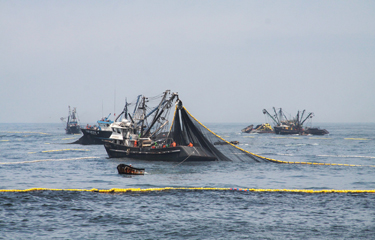Peru’s Ministry of Production (PRODUCE) has opened the second anchovy fishing season of the year in the country's south region, setting a total allowable catch (TAC) of 486,500 metric tons (MT), government gazette El Peruano reported.
The TAC is flat from that established for the first season, which ran from January through June, with the limit also set at 486,500 MT. However, as of 26 June, 2022, only 197,000 MT had been landed, or just 40.5 percent of the TAC, according to figures from the Peruvian Sea Institute (Imarpe) – a technical agency within PRODUCE that advises the state on marine conservation issues and that performs studies to evaluate the status of the Peruvian anchovy biomass.
The second season is slated to run through December, or until the TAC is reached, whichever comes first. Both the TAC and the final date of the southern region’s second fishing season may also be modified according to biological-environmental conditions, based on Imarpe findings.
Peru divides its anchovy fishing areas into two regions – south and north-central – with different capture limits and seasons set for each. The north-central is Peru’s main fishing region, with capture measuring several times that of the south region. The fishery, which targets both Engraulis ringens and Anchoa nasus for use in indirect human consumption – primarily fishmeal and fish oil used in aquaculture production – is the largest by volume in the world.
The first anchovy fishing season of the year in the country's north-central region was launched in May, with PRODUCE setting a total allowable catch (TAC) of 2.792 million MT. The TAC represented a 36.4 percent boost from the previous season, when PRODUCE established a 2.047 million MT capture limit, of which nearly the full quota was caught.
However, conditions in the north-central region have been challenging, Adriana Giudice, the CEO of Peruvian fishing company Austral Group, told SeafoodSource.
Austral, which operates 19 fishing vessels and four processing plants in Peru, and which is owned by the Norwegian group Austevoll Seafood, produces about 10 percent of the fishmeal and fish oil that Peru exports. The company itself has 7 percent of the total TAC set in Peru, and purchases another 3 percent from a network of small fishers that supply the company.
Of Austral's yearly sales of some USD 200 million (EUR 189 million), more than 90 percent comes from fishmeal and fish oil, she said, with China being Austral’s main market, and the firm being the leading exporter of fishmeal to Japan.
“This season has been a bit difficult due to weather and oceanographic issues,” Giudice said. “[There are differing] conditions of salinity and temperature, and a mixture of juveniles in the north-central region, so PRODUCE has implemented a number of bans. The control is all online to review the size of the biomass that is being extracted. According to that information, the ministry implements bans in certain areas.”
Giudice said she is unsure whether the company will reach its catch totals.
“We are not sure if we will reach the TAC of 7 percent due to climatic conditions,” she said in June. “I was recently reviewing a change in the conditions and we’ve seen the biomass has begun to separate. It’s been complicated with the bans.”
Giudice said the anchoveta fishery's status as the largest fishery in the world has brought it under an international spotlight, with the result being that monitoring of the biomass and tracking of the fishery's catch is very strict.
Austral Group has had a longstanding focus on sustainability, thanks to which it recently secured a USD 22 million (EUR 20.8 million) green loan from local financial institution Interbank after meeting several sustainability metrics in order to qualify for the reduced-rate financing. Given that focus, Giudice said that the company is aware that global warming is a risk for all species, and that it needs to plan ahead for shifting fish populations.
“Anchovy has shown to have a significant level of adaptability. However, we’re aware that climate change could alter this, so we’re performing research into what other species could be used for fishmeal, particularly for aquaculture,” she said. “Even today, the majority of the fish sold in the world comes from aquaculture, and it’s increasingly growing. There are species where fishmeal is fundamental, but anchovy biomass isn’t growing. It’s impossible to improve the ratios because we recover 100 percent of the oils and fats, so the industry needs to research what other species can be used.”
Austral boasts ISO 14,001 certification for all of its plants and fleet, as well as other certifications such as Friend of the Sea and ISO 9001. It has been a signatory to the United Nations Global Compact for over a decade, and its sustainable management practices are geared toward alignments with the United Nations' Sustainable Development Goals.
Photo courtesy of Sociedad Nacional de Pesquería







